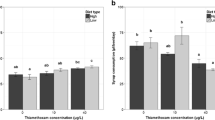Summary
The effects of the surface secretions of eight species of ants on three types of pollen were bioassayed by exposure to the integument of undisturbed, living individuals for 20 min. Ant species included Atta texana which cultures fungi by means of various types of secretions. The frequency of grains showing membrane dysfunction, and therefore reduced viability, was quantified by means of a fluorochromatic test. Comparisons of treated and control samples showed that in 46 out of 50 bioassays there was a reduction in pollen viability following exposure to ants, 38 being statistically significant. Variation in the outcome of bioassays showed differential potency among ant species and differential vulnerability among pollen types. Ant pollination may be uncommon because surface secretions, often from the metapleural glands, cause membrane dysfunction in pollen. Ant species without metapleural glands may be pollinators, but ant pollinated plants may have pollen resistant to the secretion.
Similar content being viewed by others
References
Beattie AJ (1985) The Evolutionary Ecology of Ant-Plant Mutualisms. Cambridge University Press, New York
Beattie AJ, Turnbull CL, Knox RB, Williams EG (1984) Ant inhibition of pollen function: a possible reason why ant pollination is rare. Am J Bot 71:421–426
Beattie AJ, Turnbull CL, Hough T, Jobson S, Knox RB (1985) The vulnerability of pollen and fungal spores to ant secretions: evidence and some evolutionary implications. Am J Bot 72:606–614
Beattie AJ, Turnbull CL, Hough T, Knox RB (1986) Antibiotic production: a possible function for the metapleural glands of ants. Ann Ent Soc Am 79:448–450
Heslop-Harrison J, Shivanna KR (1983) The evaluation of pollen quality, and a further appraisal of the fluorochromatic (FCR) test procedure. Theor Appl Genet 65:1–9
Holldobler B, Engel-Siegal H (1984) The metapleural gland of ants. Psyche 91:201–235
Martin MM (1970) The biochemical basis of the fungus-attine ant symbiosis. Science, 169:16–20
Peakall R, Beattie AJ, James SH (1987) Pseudocopulation of an orchid by male ants: a test of two hypotheses accounting for the rarity of ant pollination. Oecologia (Berlin) 73: 522–524
Sokal RR, Rohlf FJ (1981) Biometry. WH Freeman, New York
Weber NA (1979) Fungus culturing by ants. In: Batra LR (ed) Insect-Fungus Symbiosis. Wiley, New York, pp 77–116
Willson MF, Burley N (1985) Mate Choice in Plants: Tactics, Mechanisms and Consequences. Princeton University Press, Princeton
Author information
Authors and Affiliations
Rights and permissions
About this article
Cite this article
Hull, D.A., Beattie, A.J. Adverse effects on pollen exposed to Atta texana and other North American ants: implications for ant pollination. Oecologia 75, 153–155 (1988). https://doi.org/10.1007/BF00378829
Received:
Issue Date:
DOI: https://doi.org/10.1007/BF00378829




